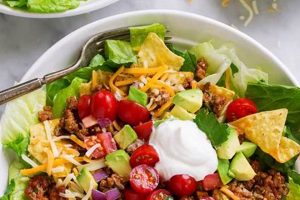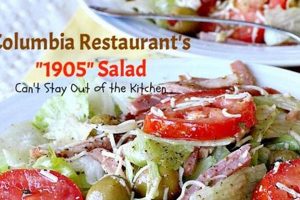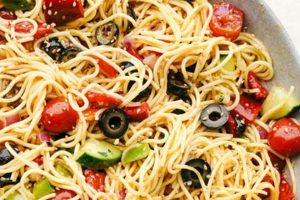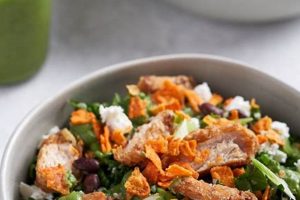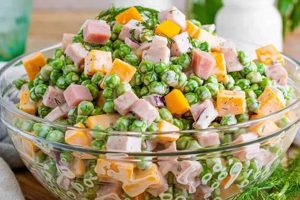Large-format, shareable salads designed for gatherings often prioritize ease of preparation, transportability, and appealing presentation. Such dishes typically feature durable ingredients that hold up well over time and can be made ahead, allowing hosts to focus on other party preparations. An example might include a pasta salad with robust vegetables, a layered salad in a clear bowl showcasing colorful ingredients, or a chopped salad with a variety of textures and flavors.
Beyond convenience, these dishes offer nutritional value and visual appeal. They can incorporate diverse flavors and textures, satisfying a range of palates and dietary needs. Historically, communal dishes like salads have played a significant role in celebrations, providing a centerpiece for shared meals and fostering conviviality. The evolution of these dishes reflects changing tastes, ingredient availability, and cultural influences.
This article will explore various aspects of creating successful salads for gatherings, including selecting appropriate ingredients, considering dietary restrictions, scaling recipes effectively, and presenting these dishes attractively.
Tips for Creating the Perfect Party Salad
Careful planning ensures a successful salad contributes significantly to any gathering. These tips offer guidance for selecting ingredients, preparing components, and presenting the final dish.
Tip 1: Choose Durable Ingredients: Opt for ingredients that maintain their texture and flavor over time. Avoid delicate greens prone to wilting, and select heartier options like romaine, kale, or radicchio. Similarly, robust vegetables such as bell peppers, carrots, and cucumbers hold up well in large-format salads.
Tip 2: Consider Make-Ahead Components: Many elements, such as dressings, roasted vegetables, or cooked grains, can be prepared in advance. This reduces stress on the day of the event and allows flavors to meld.
Tip 3: Balance Flavors and Textures: A successful salad offers a variety of tastes and textures. Incorporate contrasting elements like crunchy nuts, creamy cheeses, sweet fruits, and tangy dressings to create a well-rounded flavor profile.
Tip 4: Dress Strategically: Delicate greens should be dressed just before serving to prevent wilting. For make-ahead salads, consider serving the dressing on the side or using a thicker, more stable dressing.
Tip 5: Scale Appropriately: Accurately estimate the number of servings needed and scale the recipe accordingly. Overestimating slightly is preferable to running short.
Tip 6: Present Attractively: The visual appeal of a salad enhances its enjoyment. Consider using a variety of colors and textures, and arrange the ingredients thoughtfully. A clear bowl showcases layered salads effectively.
Tip 7: Accommodate Dietary Restrictions: Be mindful of guests’ dietary needs and offer options that cater to allergies or preferences. Provide clear labeling and consider separate serving utensils to avoid cross-contamination.
By following these guidelines, one can create a delicious and visually appealing salad that complements any gathering.
These tips provide a starting point for crafting the ideal party salad, leaving room for creativity and customization based on specific needs and preferences.
1. Fresh, High-Quality Ingredients
The success of any salad, especially one intended for a party, hinges directly on the quality of its ingredients. Fresh, vibrant produce offers superior flavor, texture, and visual appeal. A difference in quality is immediately discernible; vibrant, crisp lettuce provides a satisfying crunch compared to limp, aging leaves, and ripe, juicy tomatoes burst with flavor while mealy, flavorless ones detract from the overall dish. Using high-quality ingredients elevates a simple salad from ordinary to exceptional, creating a positive culinary experience for guests. For instance, a Caprese salad featuring fresh mozzarella, ripe tomatoes, and fragrant basil offers a far superior taste compared to one made with bland, rubbery cheese, underripe tomatoes, and dried herbs.
Selecting peak-season produce maximizes flavor and nutritional value. Farmers’ markets often provide the freshest, locally-sourced options. Beyond produce, other components benefit from careful selection. Using premium olive oil and freshly squeezed lemon juice creates a far superior vinaigrette compared to bottled dressings. Investing in quality cheeses and cured meats also significantly impacts the overall taste and presentation of the salad. Consider the difference between crumbled artisanal feta and pre-crumbled feta packaged in brine; the former offers a tangy, creamy complexity, while the latter often lacks depth of flavor and can be excessively salty.
While high-quality ingredients may represent a slightly higher initial investment, the resulting improvement in flavor and overall impression justifies the expense. Using fresh, vibrant components demonstrates care and attention to detail, conveying a sense of hospitality to guests. Ultimately, prioritizing ingredient quality enhances both the culinary and social aspects of a party, making a positive impact on the overall event.
2. Make-Ahead Preparation
Make-ahead preparation constitutes a crucial element in successful party salads. Stress reduction represents a primary benefit. Party hosts often manage multiple tasks simultaneously. Pre-preparing salad components alleviates time constraints and allows focus on other aspects of event planning. Consider a layered salad: components such as cooked grains, roasted vegetables, and even the dressing can be prepared a day or two in advance. This eliminates last-minute scrambling and ensures a relaxed atmosphere during the event itself.
Beyond time management, make-ahead preparation frequently enhances flavor development. Certain salads, especially those incorporating grains or marinated vegetables, benefit from the melding of flavors over time. For example, a marinated bean salad gains depth and complexity as the flavors of the beans, vegetables, and dressing harmonize overnight. This allows for a more nuanced and satisfying taste profile compared to hastily assembled salads. Pre-preparation also offers the advantage of ingredient stabilization. Hearty vegetables, like roasted root vegetables or blanched green beans, retain their texture and flavor when prepared in advance, contributing to a more appealing final product.
Effective make-ahead preparation necessitates strategic component selection and proper storage techniques. Durable ingredients, such as sturdy greens and roasted vegetables, hold up well over time. Conversely, delicate greens and certain fruits are best incorporated just prior to serving. Airtight containers and proper refrigeration techniques maintain freshness and prevent spoilage. Understanding these factors ensures that a make-ahead salad retains its quality and contributes positively to the overall party experience. Properly executed, make-ahead preparation enhances both the logistical and culinary aspects of serving salad at a party, resulting in a more relaxed host and a more enjoyable meal for guests.
3. Flavor Balance
Flavor balance represents a critical aspect of successful salads designed for parties. A harmonious blend of tastes elevates a salad from a simple side dish to a memorable component of the meal. Achieving this balance requires careful consideration of various flavor profiles and their interaction within the dish. A well-balanced salad engages the palate with contrasting yet complementary tastes, creating a more satisfying and enjoyable culinary experience for guests.
- Contrast and Complement:
Balancing contrasting flavors forms the foundation of a well-composed salad. Sweetness, acidity, saltiness, bitterness, and umami should interact harmoniously. For instance, the sweetness of roasted butternut squash can be balanced by the tangy bite of goat cheese and the peppery bitterness of arugula. The interplay of these contrasting flavors creates a dynamic and engaging taste experience, preventing any single flavor from dominating.
- Texture Integration:
Texture plays a significant role in flavor perception. Crunchy, creamy, chewy, and crisp textures add complexity to a salad and enhance the overall sensory experience. A salad featuring solely soft ingredients might feel monotonous, while incorporating toasted nuts, crispy croutons, or creamy avocado adds textural contrast and elevates the interplay of flavors. For example, the creamy texture of avocado complements the crunch of toasted pepitas and the juicy burst of cherry tomatoes, creating a multi-dimensional sensory experience.
- Seasonality and Ingredient Quality:
Peak-season produce inherently possesses more vibrant flavors, contributing significantly to a well-balanced salad. Fresh, high-quality ingredients possess a natural depth of flavor that enhances the overall taste profile. Using in-season ingredients also aligns with the principle of flavor optimization, as nature provides the ideal balance of sweetness, acidity, and other flavor components during peak ripeness. A summer salad featuring ripe tomatoes and fresh basil showcases this concept effectively.
- Dressing as a Unifying Element:
The dressing serves as a critical element in flavor balance, unifying the diverse ingredients and enhancing their individual characteristics. A vinaigrette, for example, provides acidity to cut through richness, while a creamy dressing adds a contrasting textural element and complements bolder flavors. The choice of dressing should complement the overall flavor profile of the salad, enhancing rather than overpowering the individual components. A light vinaigrette complements a delicate salad featuring fresh greens and herbs, while a richer, creamier dressing balances heartier ingredients like roasted vegetables or grilled meats.
By carefully considering these facets of flavor balance, constructing a party salad transcends mere ingredient combination and becomes a thoughtful exercise in culinary artistry. A well-balanced salad, offering a harmonious blend of contrasting and complementary tastes and textures, elevates the dining experience for all guests, demonstrating an attention to detail and a commitment to providing a truly enjoyable meal. The combination of fresh, high-quality ingredients, balanced flavor profiles, and a complementary dressing transforms a simple salad into a memorable culinary centerpiece for any gathering.
4. Attractive Presentation
Attractive presentation significantly elevates a party salad from a simple dish to a visually appealing centerpiece. Visual appeal stimulates appetite and enhances the overall dining experience, contributing to the festive atmosphere of a gathering. Careful consideration of color, texture, height, and serving vessel transforms a basic salad into a culinary creation that engages multiple senses.
- Color Palette:
Vibrant colors naturally attract the eye and signal freshness. Incorporating a variety of colorful ingredients creates a visually appealing salad that entices guests. Consider a salad featuring deep green spinach, bright red cherry tomatoes, orange bell peppers, and purple cabbage. The diverse color palette not only enhances visual appeal but also suggests a variety of nutrients and flavors. Monochromatic salads can be equally appealing when textures and heights are varied.
- Textural Contrast:
Visual texture enhances the perceived appeal of a salad. Contrasting textures, such as crunchy nuts, smooth avocado, and leafy greens, create visual interest. A salad composed solely of leafy greens might appear monotonous, while adding toasted nuts, croutons, or seeds introduces textural contrast, creating a more dynamic presentation. Consider the difference between a simple green salad and one incorporating crumbled feta cheese, toasted sunflower seeds, and dried cranberries. The added textures elevate the visual experience, suggesting a more complex and enjoyable flavor profile.
- Height and Dimension:
Creating height and dimension adds visual drama and prevents the salad from appearing flat and uninspired. Layering ingredients, incorporating taller elements like whole leaves or vegetable sticks, and mounding the salad in the center of the serving dish all contribute to a more dynamic presentation. Consider a layered salad in a clear glass bowl, showcasing distinct layers of ingredients like pasta, vegetables, and cheese. The layered approach not only enhances visual appeal but also allows guests to appreciate the variety of components within the salad.
- Serving Vessel Selection:
The choice of serving vessel further enhances the presentation. A large, shallow bowl or platter allows for an attractive arrangement of ingredients, showcasing their colors and textures. Clear glass bowls highlight layered salads, while wooden bowls offer a rustic touch. The serving vessel should complement the style of the salad and the overall aesthetic of the event. A sleek, modern bowl suits a contemporary salad, while a vintage serving platter complements a more traditional dish. The serving vessel itself becomes part of the presentation, contributing to the overall visual impression.
These aspects of presentation transform a party salad from a simple dish into a visually compelling centerpiece. By thoughtfully considering color, texture, height, and serving vessel, hosts demonstrate attention to detail and enhance the overall dining experience for their guests. A visually appealing salad not only stimulates appetite but also contributes to the festive atmosphere, signaling a carefully planned and thoughtfully executed meal. The combined effect of fresh, flavorful ingredients and attractive presentation creates a truly memorable culinary experience.
5. Scalability
Scalability is a critical factor when planning a salad for a party. Recipe scalability directly impacts the ability to provide sufficient portions for all attendees. A recipe easily adjusted for different group sizes ensures adequate quantities without excessive leftovers. Consider a simple vinaigrette; doubling or tripling the oil, vinegar, and seasonings easily accommodates larger gatherings. Conversely, a complex salad with numerous components and intricate assembly might prove challenging to scale proportionally. Understanding ingredient ratios and preparation techniques allows hosts to adapt recipes efficiently, ensuring sufficient quantities regardless of guest count.
Scalability considerations extend beyond ingredient quantities to encompass logistical aspects like preparation time and serving logistics. A salad requiring extensive individual assembly, such as stuffed cherry tomatoes, might be impractical for a large gathering. Conversely, a large-format salad, like a chopped salad with various components combined in a single bowl, proves more manageable for larger groups. Selecting recipes with scalable preparation methods simplifies the process and reduces time constraints, particularly crucial when hosting large events. Evaluating the complexity of preparation steps in relation to the anticipated guest count facilitates informed recipe selection, ensuring efficient execution and successful event management.
Effective scalability streamlines party preparations and minimizes food waste, contributing significantly to a successful event. Accurately assessing guest count and choosing adaptable recipes allows hosts to focus on other aspects of party planning, reducing stress and enhancing overall enjoyment. A scalable salad recipe contributes both practically and logistically to a well-executed gathering, ensuring sufficient quantities while optimizing resource management and minimizing unnecessary effort. Understanding scalability enables hosts to confidently adapt to varying group sizes, creating a positive dining experience for all attendees without undue burden.
Frequently Asked Questions
This section addresses common inquiries regarding the creation of salads suitable for parties, offering practical guidance and clarifying potential uncertainties.
Question 1: How far in advance can a party salad be prepared?
Preparation timelines depend on the specific ingredients. Robust components like roasted vegetables or grains can be prepared several days ahead. Delicate greens and some dressings are best added just prior to serving. Proper storage is crucial to maintain quality and prevent spoilage.
Question 2: What are the best types of greens for a large party salad?
Heartier greens such as romaine, kale, or spinach hold up better than delicate varieties like butter lettuce. Consider the overall flavor profile and the type of dressing when selecting greens.
Question 3: How can one accommodate various dietary restrictions when serving salad at a party?
Offer a variety of options, clearly labeling each with allergens and ingredients. Consider providing separate serving utensils to prevent cross-contamination. Offering a simple green salad alongside more complex salads allows guests to customize their plates.
Question 4: What are some strategies for scaling a salad recipe for a large group?
Ingredient quantities should be adjusted proportionally. Consider the size of the serving vessel and adjust accordingly. Some recipes, due to complex assembly, might not be suitable for large-scale preparation.
Question 5: What are some creative ways to present a salad for a party?
Consider using various serving vessels, such as platters, bowls, or individual cups. Layering ingredients in a clear glass bowl creates visual appeal. Garnishes like toasted nuts, edible flowers, or fresh herbs enhance presentation.
Question 6: What are some strategies for transporting a large salad to a party?
Choose a sturdy, leak-proof container. Transport dressings separately and add them just before serving. Consider assembling the salad at the venue if feasible. Layered salads often transport well in clear containers.
Careful consideration of these commonly encountered questions helps ensure a successful and enjoyable salad experience at any party.
The following section offers a collection of diverse salad recipes suitable for parties, providing practical examples to guide culinary endeavors.
Conclusion
Creating a successful salad for a party involves more than simply tossing ingredients together. Careful consideration of ingredient selection, flavor balance, presentation, and scalability ensures a dish that is both delicious and practical. Fresh, high-quality ingredients form the foundation of any good salad, while make-ahead preparation alleviates time constraints and allows flavors to meld. A well-balanced salad offers a harmonious blend of tastes and textures, engaging the palate and enhancing the overall dining experience. Attractive presentation elevates the salad from a simple side dish to a visually appealing centerpiece, stimulating appetite and contributing to the festive atmosphere. Scalability ensures sufficient portions for all guests, streamlining party preparations and minimizing food waste.
Ultimately, a well-executed salad enhances any gathering, contributing both culinary enjoyment and visual appeal. Attention to these key elements transforms a basic salad into a memorable component of a successful party, demonstrating thoughtful preparation and enhancing the overall experience for all attendees. Exploration of these principles empowers hosts to create salads that not only nourish but also delight, contributing to a more memorable and enjoyable occasion.


